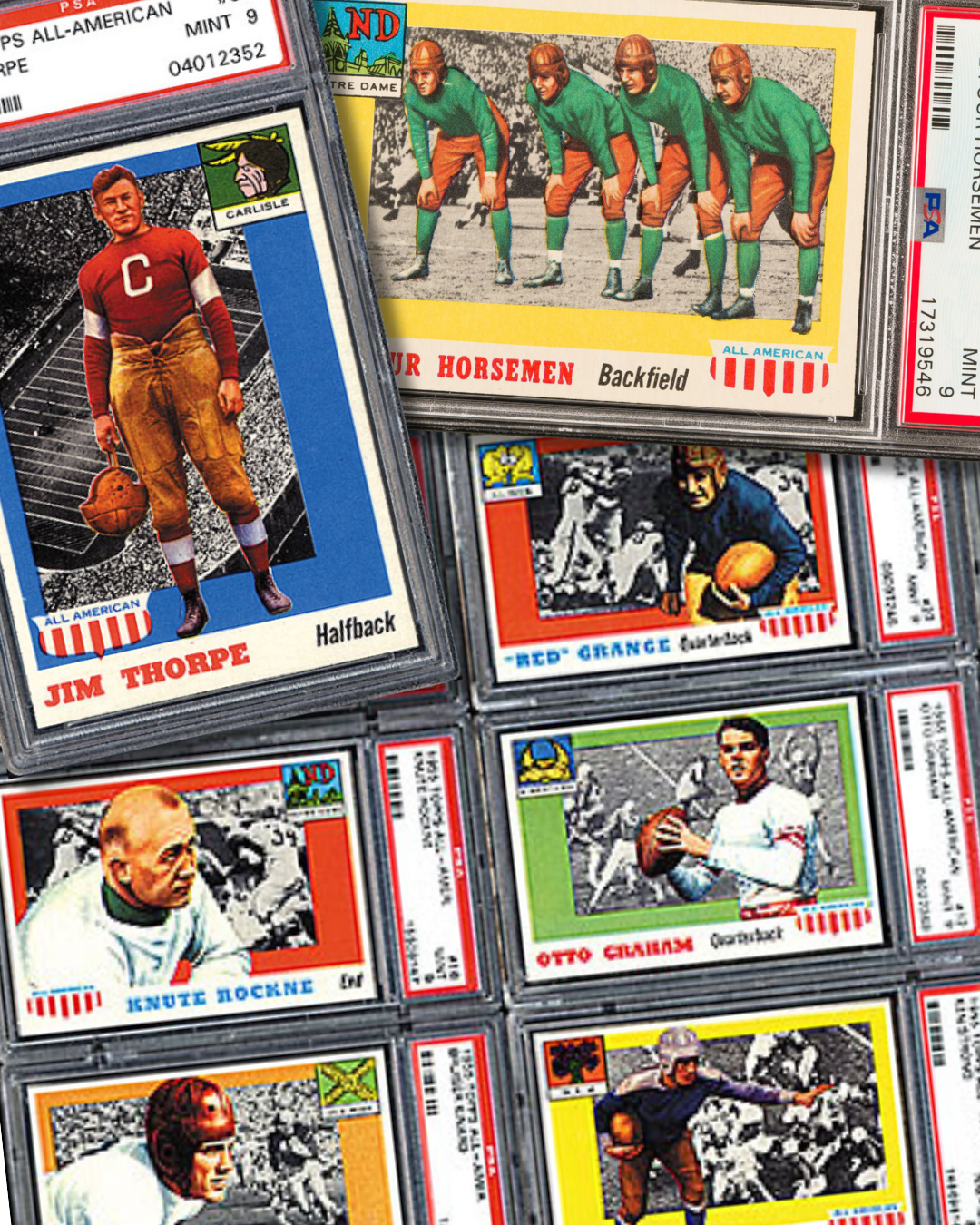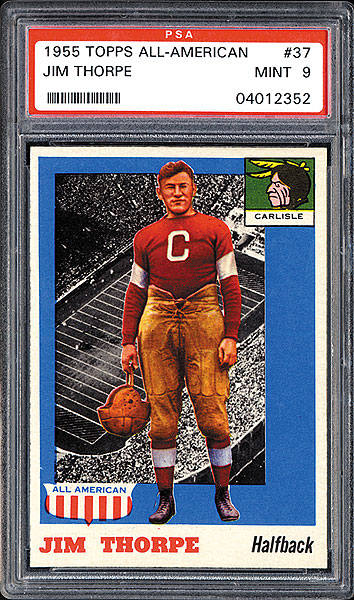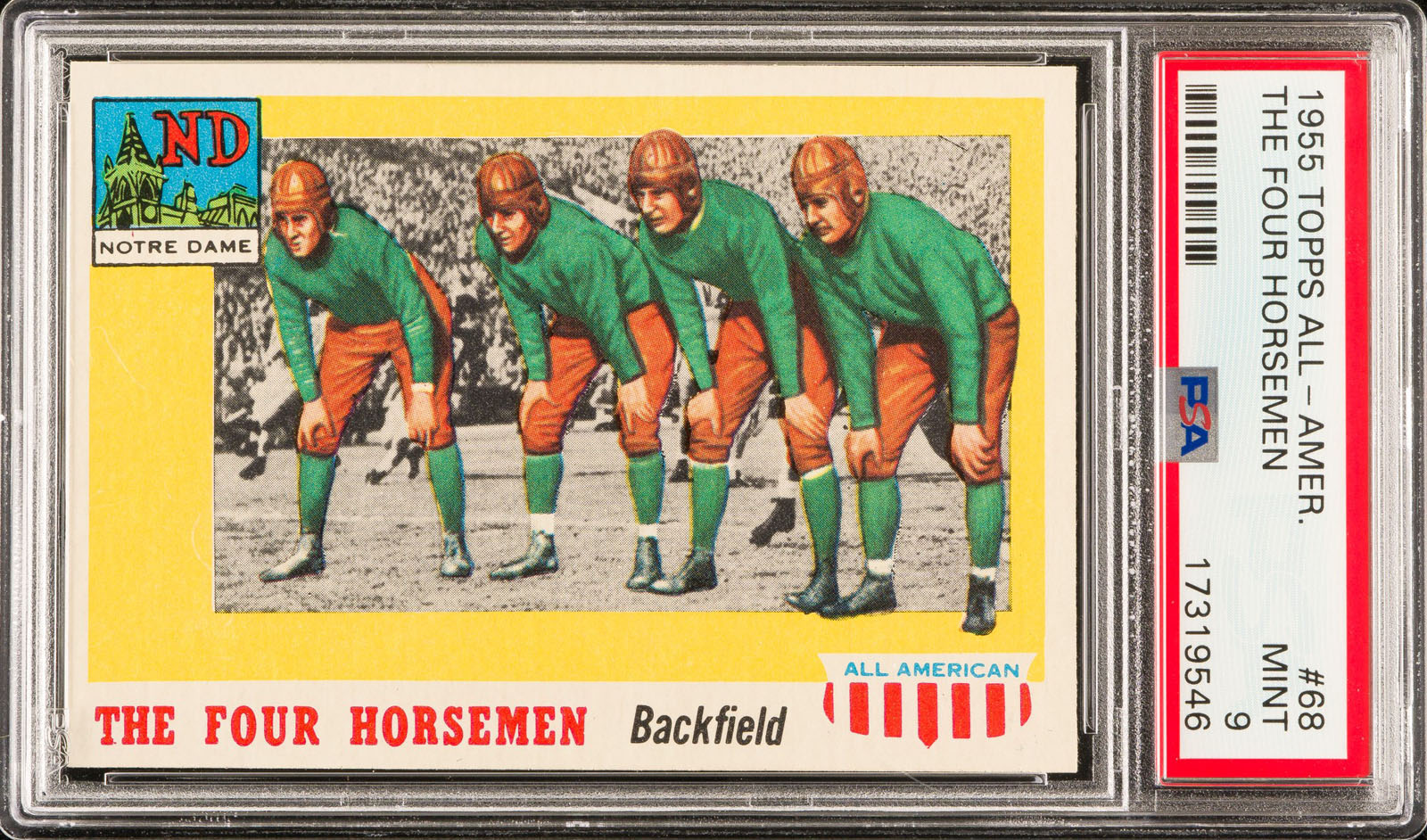The Genius Behind the 1955 Topps All-American Football Set
PJ Kinsella — September 05 2025

Seventy years ago Topps released a football card set that could have easily failed. Instead it changed the trading card landscape forever.
It’s hard to imagine that there was a time when Topps was struggling to gain industry traction. The company had to find numerous ways to outsmart its rival Bowman in order to compete. That time was seventy years ago when Topps was still in its infancy, at least from a hobby perspective.
It was only a few years earlier in 1951 that Topps had entered the baseball card market. But the company didn’t enter to roaring fanfare from collectors or even chewing gum aficionados. Quite the opposite actually. In fact, Topps’ 1951 baseball set was such a massive flop that stores began pulling them off shelves because they were simply not selling.
Luckily, thanks to some brilliant marketing ideas by Topps’ VP of Sports & Licensing Sy Berger and beautiful designs by artist Woody Gelman, the company’s 1952 issue was a massive success. The iconic set ensconced Topps in the baseball card race and positioned them as a formidable rival of Bowman, which had been producing baseball and football cards for years. Bowman had even produced a lone set of basketball cards in 1948 - the first ever for the sport - and although it was a one-time deal for the company, the ‘48 Bowman Basketball set remains one of the most important in hobby history.
Fast forward to 1955. Topps had now produced five baseball card sets, most recently its 1955 issue that was the first to use a horizontal orientation for the entire set. This was already a pioneering endeavor for Topps and one that would be used across its 1956 and 1960 sets as well.
Now that Topps was a viable player in the baseball card ecosystem and was rapidly gaining market share, it wanted to hit Bowman where it really hurt. Topps wanted to tackle the football card space, an area of trading cards around which Bowman had a stranglehold for a decade.
There was a big problem, however. Bowman had the exclusive rights with the NFL to produce football cards.
Topps now had to figure out a way to produce a quality football card that would appeal to fans during the fall and winter months without infringing upon Bowman’s exclusivity rights.
Although baseball had been America’s dominant sport for the early part of the century, by the 1950s sports fans were gravitating more towards football. The NFL’s expansion to the West Coast in 1946 with the relocation of the Cleveland Rams to Los Angeles and the San Francisco 49ers joining the league in 1950 (the franchise spent its first four years in the All-American Football Conference) coupled with the advent of televisions replacing radio broadcasting in most households meant that the gridiron - not the ballpark - was now king.
Topps had experimented with football cards in the early 1950s but, much like its 1951 Baseball set, they were a massive flop and have been nearly forgotten to time. A different, more innovative approach was needed this time.
To get around the licensing agreement that Bowman had in place with the NFL, Topps decided to target current college stars and retired NFL players for its 1955 set. They dubbed it their “All-American” set.
The set included several former Heisman trophy winners, including Jay Berwanger - the first to win the award in 1935 - along with coaching legends Knute Rockne and Amos Alonzo Stagg. Some of the retired NFL players that were featured in the set were Red Grange, Otto Graham, Sid Luckman and Sammy Baugh, among others.
All of the cards in this groundbreaking set feature a single player - except one. The Four Horsemen card portrayed the legendary quartet - Harry Stuhldreher, Don Miller, Jim Crowley and Elmer Layden -from Notre Dame’s dominant backfield during the early 1920s.
But the most recognizable card from the set features multi-sport hero Jim Thorpe. The card portrays Thorpe in a Carlisle Indians uniform and has become one of the most enduring vintage football card images. A PSA MINT 9 example holds the top recorded sale all-time from this set, finishing at $63,000 in August 2022.
Fans in non-NFL markets, especially those with prominent college programs, adored the set and it showed quickly in the sales figures. The set was released by Topps in the fall of 1955 and by January 1956, Topps had gained so much ground on Bowman through its football and baseball card sales that Bowman sold all of its football and baseball assets to Topps for $200,000.
The set continues to be adored by vintage collectors today and the majority of the cards in the set can be purchased even in high grades for just a few hundred dollars.
Sales figures aside, there’s no denying that this set is one of the most important in the history of the hobby and literally changed the face of the trading card landscape as we know it today.
This story was initially published in the 2025 edition of Hobby Intricacies which can be read in its entirety here.


